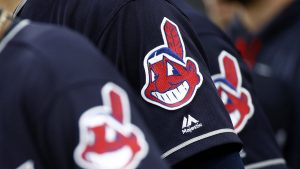I’m a huge baseball fan, so it’s no surprise that in class on Monday when Beth mentioned to our group something about the infamous Chief Wahoo logo of MLB’s The Cleveland Indians, I was immediately ready to write a blog post.
A week or two ago, the Cleveland Indians released a statement that they will get rid of the Chief Wahoo logo from their uniforms and the decor in their home stadium of Progressive Field in 2019. The first I heard of this news was when it was on Trevor Noah’s “The Daily Show” in a satirical sports segment. It’s worth a watch if you’re interested because it’s pretty funny, but also informative.
After I saw the clip and heard the news, I was kind of mad. They’re finally getting rid of the logo, but they’re not planning on rebranding the franchise. Their name will still be The Cleveland Indians, Chief Wahoo will still be present on apparel sold in stores, and fans are not prohibited from wearing the logo, just the players are. So I took a healthy approach to rant about my thoughts and ended up writing a sports editorial for The Lamron. If you are inclined to read it, the link is here.

The gist is this: the team is only getting rid of their logo on the field and in their stadium so that they will appear politically correct, but fans will still be able to proliferate the logo, and by extension the same cultural appropriation made by fans dressing up like Native Americans. So what’s the point if almost nothing will change?
Native American individuals protest outside of the stadium against the mascot and team name during high profile games, but mainly they are just ignored. In one instance back in 2014 that made headlines across the country, a man named Pedro Rodriguez presented himself in all red face attire to Native American protester Robert Roche (infamous picture shown below). Roche explained to Rodriquez how offensive his apparel was, but Rodriguez simply tried to defend himself and fellow fans for inappropriately appropriating the Native American culture. Later that year, the Cleveland Indians decided to change their main logo of Chief Wahoo to a block letter “C,” and Rodriguez eventually apologized to Roche.

So yes, it seems as if that man has learned from his mistakes, and perhaps the ClevelandIndians have too…but not really. Chief Wahoo will not go away, so long as the Cleveland Indians keep their name, keep selling their merchandise with the mascot’s face, and keep allowing fans to dress up inappropriately. The mascot is highly offensive, yes, but it’s not the only element that allows for cultural appropriation; it’s the whole franchise.
This all goes back to things Beth was saying and my group was discussing in class yesterday. Contrary to the Mardi Gras Indians who are intending to respect the Native American culture by dressing up in clothing relating to them, The Cleveland Indians are using the Native American culture for something far different: profit. The simple fact that the team will not get rid of merchandise with the logo exhibits their hold on Chief Wahoo and their vain desire to keep it. A defense for the logo by fans isn’t usually, “we’re respecting you,” which would not even be true due to the cartoonish, offensive representation of a Native American, it’s usually, “it’s just a cartoon, get over it.” Get over it. Beth was right.
With the representation of Chief Wahoo everywhere, regardless of the team attempting to get rid of it, like Beth said, the Cleveland Indians are partaking in a ritual to remind the Native Americans that they have been defeated versus partaking in a ritual that is done to honor the memory of their culture. A big franchise such as an MLB team proliferating their racist logo and fans being reluctant to stop wearing red face exemplifies a large dominating industry’s force over a minority group.
It brings me to something Roach wrote in Echoes in the Bone that we discussed in class. He writes, “Unlike the Europeans, however, the Africans did not have the opportunity to publish these revisions and amendments; their most readily available medium of cultural recollection and innovation was performance” (Roach 58). Like the Africans in this example, Native Americans did not have the luxury/privilege of preserving their culture like Europeans or other majority groups. Their culture still exists, but it was taken away and replaced by a much more dominating force. Chief Wahoo is a representation of a bigger franchise that is using a minority group to their advantage. They’re the “winners” in this case, so they apparently have every right to use and abuse the Native American culture as they please.
Chief Wahoo, however, is simply a smaller part in a much larger problem of sports teams ignorantly using Native American culture to make profit for their own teams. Don’t even get me started on all the other racist sports teams names around the sports industry like The Washington Redskins or The Atlanta Braves to name a few.
As my group talked about yesterday regarding the Mardi Gras Indians, the intent behind representing Native American culture is important, maybe even more so than the effect it creates. If the Cleveland Indians were trying to respect the Native American culture, they’d do so without a racist name and logo and impolite cultural appropriation. Instead, they use the culture to create money for themselves and for their own selfish purposes.
As I wrote in my article for the college newspaper, it’s impossible for sports teams like the Cleveland Indians to simply change their team overnight. But by barely making a change and continuing to allow fans to act culturally inappropriate, the Cleveland Indians negate any positive change they wish to make.
